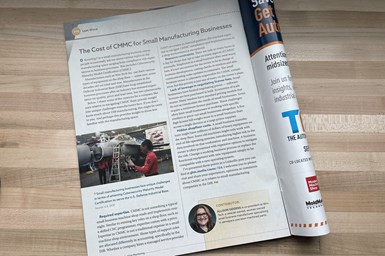Do You Want the Last Word?
I’m always looking for quality contributed articles from industry experts about a range of topics to use to button up each issue of Production Machining.
If you’d like your voice to be heard in a “Last Word” column, shoot me an email. Source: PM
Who doesn’t like having the “Last Word?” But, in this case, I’m talking about the monthly contributed column that appears on the last page of each Production Machining issue. These (non-promotional) columns don’t hit strong on machining equipment or technology. Rather, they address topics such as industry trends, manufacturing challenges, emerging markets, workforce development, company culture and so on. They also might offer general business and management tips and/or advice.
For example, this month’s Last Word column from Smithers’ Robert McVay, senior consultant — information security services, answers a few frequently asked questions the company, as a provider of testing, consulting, information and compliance services, receives from manufacturers about Cybersecurity Maturity Model Certification (CMMC).
Welcome! You’ve unlocked premium content.
That reminded me of another column that addresses CMMC from a shop management perspective. This one was contributed by Allison Giddens, co-president of Win-Tech. Small manufacturing businesses such as Win-Tech face unique challenges in terms of attaining CMMC to serve the U.S. Defense Industrial Base moving forward. Giddens shares some of the nuances (and struggles) for a company like theirs relative to navigating the journey to certification.
I then started thinking about other Last Word columns Production Machining has published since I came on board in 2020 that I particularly appreciated. Here are a few in no particular order that demonstrate the range of topics Last Word columns cover.
- “Opening Up to Possibilities” – Jim King, Okuma America Corp.’s president and COO, suggests that you, as a business leader, ask yourself if you’re wasting time defining barriers when you should be defining the possibilities instead. For him, an ankle surgery meant he’d need to spend time at home off his feet. He says this caused a change in mindset from “can’t do” to “what if.” This led King to what he says is one of the most important professional lessons he’s learned: Don’t waste time defining barriers, but define the possibilities instead.
- “Does the Used Equipment You’re Buying Have a Lien on it?” – Dan Furman, vice president of strategy for Crest Capital, suggests that when purchasing any type of used business equipment, including machine tools, to make sure the seller is allowed to sell it in the first place. This is generally confirmed with a Uniform Commercial Code (UCC) search, which should turn up most liens. But there can be more to it than that, as a UCC search does not guarantee a clean title.
- “Program Helps Shops Frame Training to Meet Their Needs” – Montez King, executive director, National Institute of Metalworking Skills (NIMS), has developed a framework for modernizing training to keep up with an ever-changing economy. Smart Training Solutions is flexible, accommodating and geared toward the needs of any individual organization. It can be helpful because some manufacturers don’t know how to define, organize and execute a results-oriented training program in their own production environment.
- “6 Tips to Financially Protect Your Manufacturing Business” – Steve Severaid, president of The Greenspan Co./Adjusters International, offers insurance tips to financially protect your manufacturing business before, during and after disaster strikes. This could be natural (such as extreme weather events) or accidental (such as a fire). For example, by performing pre-disaster preparation such as checking your insurance coverage, conducting proper care for equipment, maintaining records and assembling a team, your business can anticipate a smooth recovery following a disaster.
- “Strengthening Manufacturing Workplaces Through Active Listening” – Max Farrell, founder and CEO of WorkHound, believes a good strategy to weather the storms of manufacturing market upheavals and unpredictable factors is to commit to continuous and active employee listening. The key advantage of this approach is that it keeps leaders in touch with their employees’ experiences, ideas and apprehensions.
This is just a small sample of the Last Word columns that have appeared in every issue of Production Machining since its launch in 2001. If you’d like your voice to be heard, shoot me an email.
Read Next
5 Aspects of PMTS I Appreciate
The three-day edition of the 2025 Precision Machining Technology Show kicks off at the start of April. I’ll be there, and here are some reasons why.
Read MoreA Tooling Workshop Worth a Visit
Marubeni Citizen-Cincom’s tooling and accessory workshop offers a chance to learn more about ancillary devices that can boost machining efficiency and capability.
Read MoreDo You Have Single Points of Failure?
Plans need to be in place before a catastrophic event occurs.
Read More














.jpg;maxWidth=300;quality=90)




.jpg;maxWidth=970;quality=90)